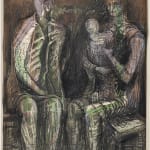Henry Moore 1898-1986
Shelterers, c.1940-41
pencil, wax crayon, watercolour, pen and ink with gouache
13 1/4 x 11 3/8 inches
33.5 x 28.9 cm
33.5 x 28.9 cm
signed lower right
Further images
While travelling on the London underground on the evening of 11 September 1940, Henry Moore and his wife were forced to seek refuge in Belsize Park station during a sudden...
While travelling on the London underground on the evening of 11 September 1940, Henry Moore and his wife were forced to seek refuge in Belsize Park station during a sudden air raid strike. On disembarking the train Moore was confronted by scores of people sheltering there, as he recalls:
“We stayed there for an hour and I was fascinated by the sight of people camping out deep under the ground. I had never seen so many reclining figures and even the holes out of which the trains were coming seemed to me like the holes in my sculpture. And there were intimate little touches. Children fast asleep, with trains roaring past only a couple of yards away. People who were obviously strangers to one another forming tight little intimate groups. They were cut off what was happening up above, but they were aware of it. There was tension in the air.” 1
Moore produced his first ‘Shelter Drawing’, Women and Children in the Tube, (coll. Imperial War Museum) the following day. He returned to these makeshift shelters on numerous occasions and went on to produce a series of over 300 drawings informed by these visits, including Shelterers, c.1941. 160 of these works were contained in two sketchbooks, another 80 were produced on loose sheets and a number on larger sheets were created at the request of the War Artists Advisory Committee. However, it is important to note that Moore began his shelter drawings as a personal project and it was not until January 1941 that he agreed to Kenneth Clark’s proposal that the WAAC purchase 31 of his larger drawings. The purchase of these drawings led almost immediately to a further commission from the WAAC in August 1941 for Moore to make drawings of miners at the Wheldale Colliery in Yorkshire.
Conscious to respect the already limited privacy of the shelterers, Moore would typically observe silently from life, make brief notes in a pocket book and return home at dawn to execute drawings from memory. Consequently his drawings were a synthesis of memories and experiences and, rather than being portraits of specific inhabitants, the subjects depicted are anonymous, archetypal, almost idol-like figures that embody the common experience of suffering and resilience amongst the civilian population in London during the war.
The compositions of these drawings would later find their three-dimensional equivalent in some of the first works Moore created after returning to sculpture in 1943, such as Two Seated Women and a Child, 1945.
1 Julian Andrews, London’s War, The Shelter Drawings of Henry Moore, Lund Humphries, Hampshire, 2002, p36
“We stayed there for an hour and I was fascinated by the sight of people camping out deep under the ground. I had never seen so many reclining figures and even the holes out of which the trains were coming seemed to me like the holes in my sculpture. And there were intimate little touches. Children fast asleep, with trains roaring past only a couple of yards away. People who were obviously strangers to one another forming tight little intimate groups. They were cut off what was happening up above, but they were aware of it. There was tension in the air.” 1
Moore produced his first ‘Shelter Drawing’, Women and Children in the Tube, (coll. Imperial War Museum) the following day. He returned to these makeshift shelters on numerous occasions and went on to produce a series of over 300 drawings informed by these visits, including Shelterers, c.1941. 160 of these works were contained in two sketchbooks, another 80 were produced on loose sheets and a number on larger sheets were created at the request of the War Artists Advisory Committee. However, it is important to note that Moore began his shelter drawings as a personal project and it was not until January 1941 that he agreed to Kenneth Clark’s proposal that the WAAC purchase 31 of his larger drawings. The purchase of these drawings led almost immediately to a further commission from the WAAC in August 1941 for Moore to make drawings of miners at the Wheldale Colliery in Yorkshire.
Conscious to respect the already limited privacy of the shelterers, Moore would typically observe silently from life, make brief notes in a pocket book and return home at dawn to execute drawings from memory. Consequently his drawings were a synthesis of memories and experiences and, rather than being portraits of specific inhabitants, the subjects depicted are anonymous, archetypal, almost idol-like figures that embody the common experience of suffering and resilience amongst the civilian population in London during the war.
The compositions of these drawings would later find their three-dimensional equivalent in some of the first works Moore created after returning to sculpture in 1943, such as Two Seated Women and a Child, 1945.
1 Julian Andrews, London’s War, The Shelter Drawings of Henry Moore, Lund Humphries, Hampshire, 2002, p36
Provenance
Redfern Gallery, LondonEdmund Arnold Esq., acquired from the above 15 September 1942
Richard Green Gallery, London
Private Collection, UK
Literature
Ann Garrould (ed.), Henry Moore Volume 7, Complete Drawings 1984-86, Addenda and Index 1916-1986, The Henry Moore Foundation in association with Lund Humphries, HumphiresMuch Hadham, 2003, cat no.HMF 1826a, illus b/w p23Join our mailing list
* denotes required fields
We will process the personal data you have supplied to communicate with you in accordance with our Privacy Policy. You can unsubscribe or change your preferences at any time by clicking the link in our emails.





